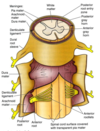Week 1 - C - Neuroanatomy 2 - Spinal Anatomy And Tracts Flashcards
In the spinal cord there are how many paired nerves? What do the cervical and lumbar enlargement portions of the spinal cord supply?
31 paired spinal nerves Cervical supplies upper limb Lumbar supplies lower limb

How is the anterior rami formed from the spinal cord?
The spinal cord gives off anterior rootlets that come together to make anterior roots The anterior and posterior roots then fuse together to form the spinal nerve at the intervertebral foramen which splits into the anterior and posterior rami

What is contained into the dorsal root ganglion of the posterior root?
This contains cell bodies of sensory neurons
The spinal cord terminates in a tapered cone-shape called the what? What vertebral level is this usually?
This is the conus medullaris L2
What is the continuation of the spinal cord composed of pia mater that runs from the conus medullaris to the coccyx? What is the function of this cotninuation?
This is the filum terminale - this anchors the spinal cord

The spinal meninges are continuous with the cranial meninges via the foramen magnum. What are the three meningeal layers?
This would be the dura mater, arachnoid mater and pia mater
Just as the filum terminale anchors the spinal cord, what is the ligament that attaches the lateral aspect of the spinal cord to the dura matter known as and helps anchor the spinal cord?
This is the denticulate ligament and is composed of pial and arachnoid tissue

Is white or grey matter on the outside of the spinal cord? Which is H shaped?
The white matter is on the outside of the spinal cord with the grey matter in the H shaped inside
A small central canal extends the length of the spinal cord. What does this open into rostrally?
This opens into the 4th ventricle

The white matter is conventionally described as being made up of posterior, lateral (x2), and anterior funiculus, what is the smaller divisions of the funiculus known as? What is the grey matter of the spinal cord divided into?
Smaller divisions of funiculus are known as fasiculus It is divided into 4 horns left and right anterior and posterior horns hence the H shape

How is it possible to tell apart the anterior and posterior horns if given an unlabelled spinal cord?
The posterior horns extend fully through the white matter of the spinal cord

At spinal segments T1 to L2 there is also a smaller lateral horn What is contained in the lateral horns here?
The preganglionic sympathetic neurons for thoracolumbar outflow lie here

The arterial blood supply to the spine contains 5 main arterial supplies What are they? and where are they derived from?
3 longitudinal arteries One anterior and 2 posterior that originate from the vertebral arteries Segemntal arteries derived from the vertebral, intercostal and lumbar arteries Radicular arteries derived from ventral and dorsal nerve roots

What are the venous drainage veins of the spinal cord known as?
These are the longitudinal and sentimental veins
What is the space between the dura mater and bone of the vertebra that can be used for anaesthesia? Why must you be careful when accessing this space?
This is the epidural space This is because in this space venous plexus’ exist and dont want to rupture one causing an epidural haemorrhage
Where is the primary somatosensory cortex? Which love is it in?
It is located posterior to the central sulcus in the post-central gyrus It is in the postcentral gyrus of the parietal lobe
Where is the primary motor cortex?
This is in he precentral gyrus located in the frontal lobe
What is the major ascending spinal tract involved in fine touch and conscious proprioception? What is proprioception?
This would be the dorsal column/medial lemniscus spinal tract Proprioception is understanding ones movement in space
Where do the fibres cross over in the dorsal column? What is crossing over also known as?
They cross over in the medulla It is known as decussation
What is the word column in dorsal column also known as?
This is also known as the dorsal funiculus
What does the dorsal funiculus contain?
Contains the fasciculus gracilis and fasciculus cuneatus
Where do the axons for the fasciculus gracilis and the fasciculus cuneatus come from?

Fasciculus gracilis (graceful leg) - comes from the lower limb Fasciculus cuneatus - comes from the upper limb
Does the fasciculus cuneatus or gracilis lie medial to one another?
The fasciculus gracilis lies medial to the fasciculus cuneatus

In the dorsal column, explain the pathway if the axons came from eg the upper limb? (remember the 1st order, 2nd order and 3rd order neruones)
https://s3.amazonaws.com/classconnection/403/flashcards/11907403/png/picture1jpggifjpggif-15E344988D821EF1706.png











